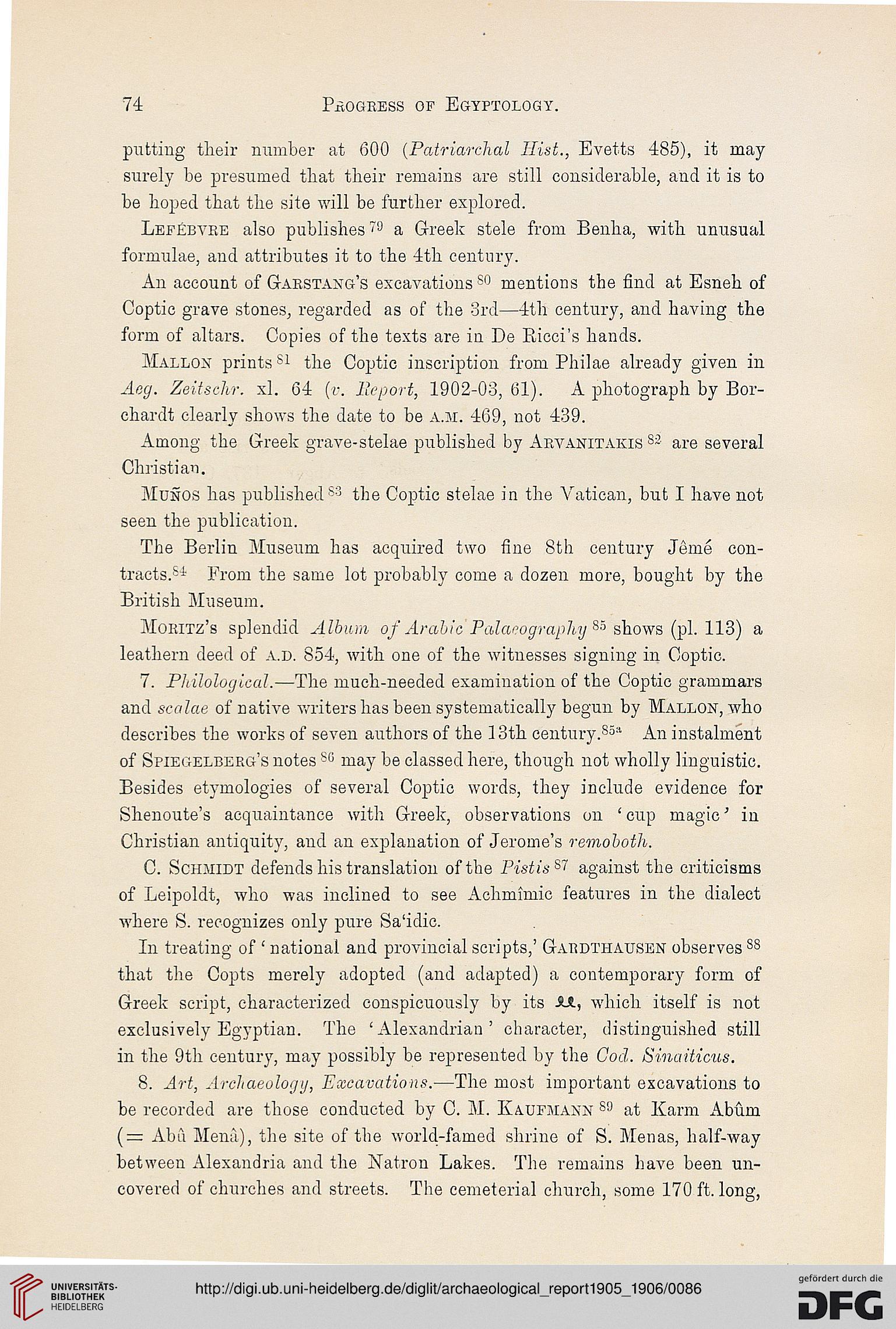74
Progress of Egyptology.
putting their number at 600 (Patriarchal Hist., Evetts 485), it may
surely be presumed that their remains are still considerable, and it is to
be hoped that the site will be further explored.
Lefebvke also publishes ~'J a Greek stele from Benha, with unusual
formulae, and attributes it to the 4th century.
An account of Garstaxg's excavationsso mentions the find at Esneh of
Coptic grave stones, regarded as of the 3rd—4th century, and having the
form of altars. Copies of the texts are in De Ricci's hands.
Mallon printsS1 the Coptic inscription from Philae already given in
Aeg. Zeitschr. xl. 64 (v. Report, 1902-03, 61). A photograph by Bor-
chardt clearly shows the date to be a.m. 469, not 439.
Among the Greek grave-stelae published by Aevanitakis S2 are several
Christian.
Munos has published83 the Coptic stelae in the Vatican, but I have not
seen the publication.
The Berlin Museum has acquired two fine 8th century Jeme con-
tracts.5* From the same lot probably come a dozen more, bought by the
British Museum.
Mokitz's splendid Album of Arabic Palaeography 85 shows (pi. 113) a
leathern deed of a.d. 854, with one of the witnesses signing in Coptic.
7. Philological.—The much-needed examination of the Coptic grammars
and scalae of native writers has been systematically begun by Mallon, who
describes the works of seven authors of the 13th century.85" An instalment
of Spiegelberg's notesS(i may be classed here, though not wholly linguistic.
Besides etymologies of several Coptic words, they include evidence for
Shenoute's acquaintance with Greek, observations on 'cup magic' in
Christian antiquity, and an explanation of Jerome's remoboth.
C. Schmidt defends his translation of the Pistis^ against the criticisms
of Leipoldt, who was inclined to see Aehmimic features in the dialect
where S. recognizes only pure Sa'idic.
In treating of ' national and provincial scripts,' Gardtiiausen observesss
that the Copts merely adopted (and adapted) a contemporary form of
Greek script, characterized conspicuously by its XX, which itself is not
exclusively Egyptian. The 'Alexandrian' character, distinguished still
in the 9th century, may possibly be represented by the Cod. Sinaiticus.
8. Art, Archaeology, Excavations.—The most important excavations to
be recorded are those conducted by C. M. Kaufmann 89 at Karm Abuni
(= Abu Menu), the site of the world-famed shrine of S. Menas, half-way
between Alexandria and the Natron Lakes. The remains have been un-
covered of churches and streets. The cemeterial church, some 170 ft. long',
1 O'
Progress of Egyptology.
putting their number at 600 (Patriarchal Hist., Evetts 485), it may
surely be presumed that their remains are still considerable, and it is to
be hoped that the site will be further explored.
Lefebvke also publishes ~'J a Greek stele from Benha, with unusual
formulae, and attributes it to the 4th century.
An account of Garstaxg's excavationsso mentions the find at Esneh of
Coptic grave stones, regarded as of the 3rd—4th century, and having the
form of altars. Copies of the texts are in De Ricci's hands.
Mallon printsS1 the Coptic inscription from Philae already given in
Aeg. Zeitschr. xl. 64 (v. Report, 1902-03, 61). A photograph by Bor-
chardt clearly shows the date to be a.m. 469, not 439.
Among the Greek grave-stelae published by Aevanitakis S2 are several
Christian.
Munos has published83 the Coptic stelae in the Vatican, but I have not
seen the publication.
The Berlin Museum has acquired two fine 8th century Jeme con-
tracts.5* From the same lot probably come a dozen more, bought by the
British Museum.
Mokitz's splendid Album of Arabic Palaeography 85 shows (pi. 113) a
leathern deed of a.d. 854, with one of the witnesses signing in Coptic.
7. Philological.—The much-needed examination of the Coptic grammars
and scalae of native writers has been systematically begun by Mallon, who
describes the works of seven authors of the 13th century.85" An instalment
of Spiegelberg's notesS(i may be classed here, though not wholly linguistic.
Besides etymologies of several Coptic words, they include evidence for
Shenoute's acquaintance with Greek, observations on 'cup magic' in
Christian antiquity, and an explanation of Jerome's remoboth.
C. Schmidt defends his translation of the Pistis^ against the criticisms
of Leipoldt, who was inclined to see Aehmimic features in the dialect
where S. recognizes only pure Sa'idic.
In treating of ' national and provincial scripts,' Gardtiiausen observesss
that the Copts merely adopted (and adapted) a contemporary form of
Greek script, characterized conspicuously by its XX, which itself is not
exclusively Egyptian. The 'Alexandrian' character, distinguished still
in the 9th century, may possibly be represented by the Cod. Sinaiticus.
8. Art, Archaeology, Excavations.—The most important excavations to
be recorded are those conducted by C. M. Kaufmann 89 at Karm Abuni
(= Abu Menu), the site of the world-famed shrine of S. Menas, half-way
between Alexandria and the Natron Lakes. The remains have been un-
covered of churches and streets. The cemeterial church, some 170 ft. long',
1 O'





